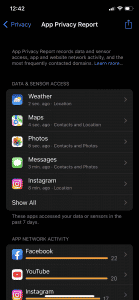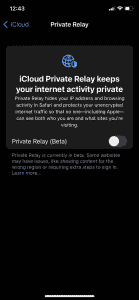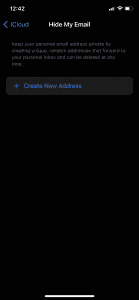An Apple a day keeps the trackers away. Is your nonprofit ready for the privacy switch?
A step toward transparency and into controversy
Let me set the scene—it’s April 2021, and Apple has just announced iOS 14.5 and a ton of new features that are going to come with it—for example, the ability to unlock your phone using your Apple Watch, new emojis, Siri enhancements and, the subject of this blog, privacy enhancements.
It was then that Apple did what every advertiser and most marketing professionals would say is unfathomable: They gave app tracking options to the users. From the moment users downloaded iOS 14.5, they had the ability to allow or prohibit tracking from apps. Apple expanded on the feature in a 2021 press release which said, “App Tracking Transparency requires apps to get the user’s permission before tracking their data across apps or websites owned by other companies for advertising, or sharing their data with data brokers.” For Apple, this was just step one.
![]()
iCloud + Privacy
Next, in June 2021, Apple released iOS 15. Some of the major features introduced included:
Mail Privacy Protection (MPP):
This feature, which turned heads at many big companies, stops senders from adding invisible pixels to the emails they send, which stops companies from seeing when an email is opened and masks IP addresses. This feature is for anyone using the mail app on their Apple device.
App Privacy Report:
Every time we download a new app, the first thing it does is ask for access to your location, photos, microphone, and/or your camera. This new report now allows you to see how many times an app accesses these things and adjusts as needed. Apple didn’t stop there, though—the report will also show you what URLs are accessing your shared data. This allows transparency that users haven’t seen before.

iCloud+:
When this was first talked about, many were worried—protecting data shouldn’t come at a price. However, this shaped up to be a little more than that—with iCloud+, you can now purchase more iCloud storage and gain some fancy privacy features. Although there are a few features, there are two that really jump out: iCloud Private Relay and Hide My Email.
iCloud Private Relay is Apple’s step toward encrypted web browsing, although it doesn’t have all the capabilities of a VPN. Private Relay will allow users to hide their IP address but allows them to still receive localized content. Hide My Email is exactly what you’d think; when you go to sign up, order, or any other action that requires submitting an email, Apple will give you the option to use a dummy email that then forwards all messages to your actual email. As a user, you’re getting all of the content you want without taking the risk of your email being moved around the internet.


Keep your tracking on track
Now that Apple pulled out the Queen’s Gambit in the privacy chess match, here are some things that your nonprofit can do to help make sure your marketing efforts are less impacted.
Email Campaigns:
With Hide My Email impacting open rate, it will be incredibly important to shift the goals of your email campaigns. Having large, clickbaity subject lines may be less effective. When you can’t just go for eyes, you must switch to an action-first approach. Give users a clear call to action within your email. Send users to donation forms, sign-ups, or a specific webpage. UTMs (read my blog about UTMs here) are also allowed, so be sure to include those to help identify the source, campaign, or other identifiers.
Platform Advertising:
Companies such as Snap and Meta took a big hit when Apple released these features, but they have found ways that you can still track users without 3rd party cookies. For example, Meta released their Conversions API, or CAPI for short. This allows for server-side tracking instead of using browser pixel tracking that could be blocked by a user. Google introduced server-side tagging for Google Tag Manager, which helps with data protection, among other things. They also recently released Google Enhanced Conversions, which allows ad platforms to collect and hash 1st party data such as email addresses to help track across devices without using 3rd party cookies. This is all part of Google’s cookie-free by 2023 plan.
Build trust, not data mines
Apple isn’t forcing users to stop tracking; it is still totally their choice. The bottom line? Transparency never hurts, especially in the nonprofit sector. If you let people know how their data is being used, they are more likely to allow tracking. Deliver content that users enjoy, and they will be open to receiving it. We, as users, nonprofits, and marketing professionals can’t look at this as a roadblock but as an opportunity to create a better and more ethical experience.
Need help preparing for the switch? Reach out to our team today.